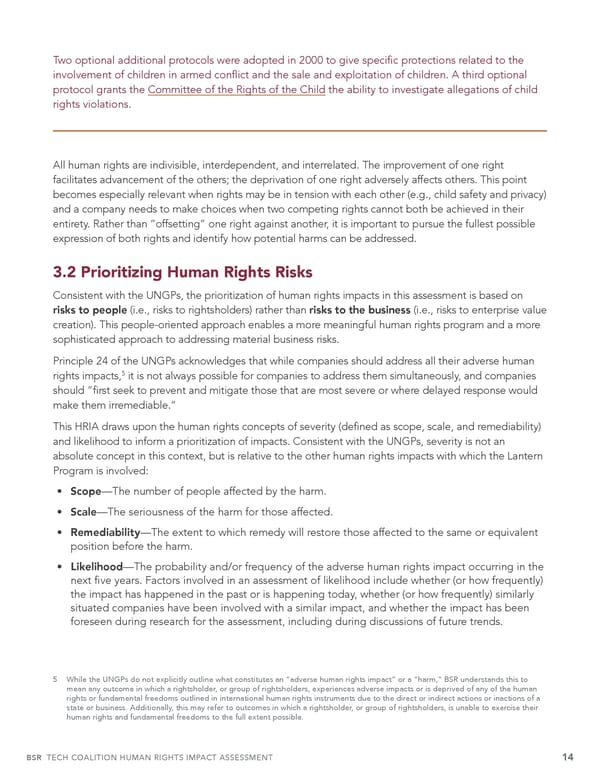Two optional additional protocols were adopted in 2000 to give speci昀椀c protections related to the involvement of children in armed con昀氀ict and the sale and exploitation of children. A third optional protocol grants the Committee of the Rights of the Child the ability to investigate allegations of child rights violations. All human rights are indivisible, interdependent, and interrelated. The improvement of one right facilitates advancement of the others; the deprivation of one right adversely affects others. This point becomes especially relevant when rights may be in tension with each other (e.g., child safety and privacy) and a company needs to make choices when two competing rights cannot both be achieved in their entirety. Rather than “offsetting” one right against another, it is important to pursue the fullest possible expression of both rights and identify how potential harms can be addressed. 3.2 Prioritizing Human Rights Risks Consistent with the UNGPs, the prioritization of human rights impacts in this assessment is based on risks to people (i.e., risks to rightsholders) rather than risks to the business (i.e., risks to enterprise value creation). This people-oriented approach enables a more meaningful human rights program and a more sophisticated approach to addressing material business risks. Principle 24 of the UNGPs acknowledges that while companies should address all their adverse human 5 rights impacts, it is not always possible for companies to address them simultaneously, and companies should “昀椀rst seek to prevent and mitigate those that are most severe or where delayed response would make them irremediable.” This HRIA draws upon the human rights concepts of severity (de昀椀ned as scope, scale, and remediability) and likelihood to inform a prioritization of impacts. Consistent with the UNGPs, severity is not an absolute concept in this context, but is relative to the other human rights impacts with which the Lantern Program is involved: • Scope—The number of people affected by the harm. • Scale—The seriousness of the harm for those affected. • Remediability—The extent to which remedy will restore those affected to the same or equivalent position before the harm. • Likelihood—The probability and/or frequency of the adverse human rights impact occurring in the next 昀椀ve years. Factors involved in an assessment of likelihood include whether (or how frequently) the impact has happened in the past or is happening today, whether (or how frequently) similarly situated companies have been involved with a similar impact, and whether the impact has been foreseen during research for the assessment, including during discussions of future trends. 5 While the UNGPs do not explicitly outline what constitutes an “adverse human rights impact” or a “harm,” BSR understands this to mean any outcome in which a rightsholder, or group of rightsholders, experiences adverse impacts or is deprived of any of the human rights or fundamental freedoms outlined in international human rights instruments due to the direct or indirect actions or inactions of a state or business. Additionally, this may refer to outcomes in which a rightsholder, or group of rightsholders, is unable to exercise their human rights and fundamental freedoms to the full extent possible. BSR TECH COALITION HUMAN RIGHTS IMPACT ASSESSMENT 14
 Tech Coalition Human Rights Impact Assessment of the Lantern Program Page 13 Page 15
Tech Coalition Human Rights Impact Assessment of the Lantern Program Page 13 Page 15